|
Topic: |
Automotive Lighting
6: Selecting Flash equipment |
|
Author/Copyright: |
John Jovic |
There are many different kinds of flashes
which can be used for photographing cars. Your particular needs or style of
photography will therefore drive flash equipment choice. Possibly the only common factor
amongst all the suitable options is that the flashes used for car photography
are normally positioned carefully around the car being photographed, ie
'off-camera'. The flashes generally have no reason to communicate with a
camera, other than to know when to fire, so there is no reason to use
dedicated or proprietary wireless flashes from the same company that
made your camera. Almost any flash is fine for static car photography
(see warnings about Trigger Voltages below) as long as it suits the way
you want to work and your budget. Dedicated flashes are handy for simple fill flash such as
when photographing people, a
car show or event, but have relatively little practical
application for static car photography.
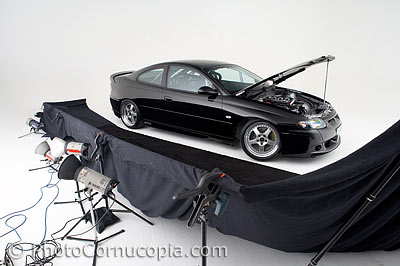 |
|
 |
|
A barrage of Monolights is used here
to create smooth tonal gradation in the side of the car being
photographed. This kind of flash equipment is great for a studio but quite
cumbersome in the field. |
|
Portable, battery
powered strobes are ideal for location car photography. Note the
lack of light modifiers such as softboxes, brollies etc. which can
be counterproductive in car photography. |
For those unfamiliar with some of the
terms used to describe electronic flash there is a brief definition of
terms at the bottom of this page.
Flashes or strobes fall into a few broad
groups and not all of them are well suited to car photography.
The descriptions below are generalizations as it's not possible
to explore the details and specifications of every brand and
model of lighting on the market.
|
Mains powered Monolights or Power Packs
(also called Floor Packs) |
Mains powered strobes are the
strobes typically used in studios or in environments where mains power is readily
available. They are typically the most flexible and powerful strobes but
their physical size and practical constraints such as power cables can
make them difficult to use on location. Some strobes are fully self
contained and are called Monolights. Monolights tend to be bulky because
they enclose everything that they need to work. All you have to do is
plug them into mains power. Another common style of strobe lighting is
to have a Power Pack, which is connected to mains power and houses the
bulk of the electronics, then smaller Flash Heads are then
connected to the Power Pack itself. These systems allow much smaller Flash
Heads and greater versatility and power output but tend to be very
expensive and their Power Packs are often very large, heavy and
generally need to be quite close to the Flash Heads themselves. Elinchrom, Bowens, Broncolour, Hensel, Norman, Profoto, Visatec
Paul C. Buff (AlienBees/Einstein) are just
a few of the major suppliers of the kinds of lighting equipment
described above. |
|
Pro's |
Con's |
- Powerful and with very fast
recycle times.
- Flexible, can be used with a large
range of attachments such as soft boxes, Fresnel spots, Ring flashes
and light modifiers.
- Consistent and repeatable colour
temperature and light output.
- Tungsten Modeling lights are
standard in most mains powered units and they allow you to see the
effect of the strobes as you adjust them.
- Built in slaves.
- Some have built in radio receivers
such as PocketWizards.
- The most powerful strobes
available are Power Pack systems.
|
- Heavy and often physically large.
- Expensive.
- Can be cumbersome to use because
of the cables needed to connect them to Mains power. These cables
will also tend to be reflected in the panels of a car so hiding the
cables can also be problematic.
- They may need a generator or
Inverter to be able to use them
outside of a studio or away from Mains power.
- Monolights can blow fuses on a
mains power circuit if too many are connected to the same line. This is a
particular problem with high powered Monolights, eg over 1000WS.
Once the fuse is blown you may not have access to the fuse box to
repair/replace it!
|
Battery powered Monolights or Power Packs
For example;
Elinchrom Ranger RX
Elinchrom Quadra RX
Lumedyne
Bowens Gemini
etc. |
Battery powered units are by far the most
useful and practical for car location photography. Many of the Monolights mentioned above can be powered with Inverters which are run
from a battery, often a 12 Volts Sealed Lead Acid Battery (SLA). There are also battery powered versions of many of the
strobes mentioned above. These usually have their own Power Pack, just
like a mains powered unit, but it is run from an internal rechargeable
battery. These units are usually quite powerful, often have replaceable
batteries (so you can have spares with you) and some times even have modeling lights. Elinchrom, Lumedyne, Bowens, Broncolour, Hensel,
Norman, Profoto are just a few of the major suppliers of the kinds of
lighting equipment described above.
The Einstein from Paul C. Buff is a fairly compact mains powered
Monolight which can be run from a very compact Inverter (Vagabond Mini
Lithium). If one Inverter is used per Einstein then this makes a fairly
compact unit without the problem of mains power cables running along the
ground. |
|
Pro's |
Con's |
- Can be powerful and with very fast
recycle times.
- Flexible, can be used with a large
range of attachments such as soft boxes, Ring flashes and light
modifiers.
- Consistent and repeatable colour
temperature and light output.
- Some have modeling lights.
- Some have built in slaves.
|
- Heavy and often physically large.
- Expensive.
- Can be cumbersome to use because
of the cables needed to connect the flash to the Battery Pack
itself. These cables will also tend to be reflected in the panels of
a car so hiding the cables can also be problematic.
- Battery packs and spare batteries
can be very expensive.
- Although they are often quite
powerful their useable battery life is determined by the power of
the flashes attached so high powered flashes lead to a shorter
battery life. Using modelling lights drains batteries very quickly.
- They are not as powerful as mains
powered Power Packs with Flash Heads.
|
Speedlights, 'Hotshoe' or bracket mount
flashes
(intended for use on
camera)
For example;
Canon 580EXII
Nikon SB-24, 26 etc
Metz 54's, 60's etc
Vivitar 285's
etc |
Battery powered hot shoe mounted flashes, or
flashes attached using a bracket, are by far the most useful and practical for car location
photography on a budget, although, they should probably never be used on
the camera itself. These units are often very cheap and depending on
your requirements can have enough power for many kinds of car
photography. The types of units referred to are those such as Canon
580EXII, Nikon SB-26, Metz 54's, Vivitar 285's etc. |
|
Pro's |
Con's |
- Relatively fast recycle times,
often a couple of seconds.
- Can be very cheap.
- Usually very small and light so
they are very convenient in terms of where they can be positioned,
such as in engine bays. Their small 'footprint' also
makes them easy to hide in a cars reflection.
- Potentially disposable due to low
replacement cost.
- They usually use commonly
available and cheap AA batteries.
- May have HSS (High Speed Synch) or
other proprietary systems allowing the strobe to synch at abnormally
high shutter speeds.
|
- Low to moderate power and hence
limited application.
- Can't be used with many light
modifiers which have the effect of reducing light output even
further.
- No modeling lights.
- No built in slaves (except Nikon
SB-26, maybe others?).
- It's easy to forget that you left
one under a wheel and then have the cars owner move the car and run
over your flash. Ask me how I know that...
|
|
Dedicated flashes, eg.
Canon, Nikon |
Dedicated flash systems such as iTTL, E-TTL
and the proprietary wireless systems from Canon, Nikon and others are
great for their intended purposes but are not so useful for static car
photography. Dedicated flash systems are great for on
camera use at car events or car shows where they are great for getting
excellent fill flash exposures. Several companies makes flashes which simulate
dedicated units from Canon, Nikon and others. These are a great option
in that they often use an adapter which allows the same flash to be used
on several systems, just by replacing the adapter, not the whole flash
(check manufacturers specifications). |
|
Pro's |
Con's |
- The same as above.
- Excellent for fill flash
applications such as when shooting people, car shows or events.
- High end flashes often have
functionality allowing the unit to synch with the camera at speeds
beyond the cameras maximum flash synch speed.
|
- The same as above.
- These are generally the most
expensive flash units as they are often the latest model and most
sophisticated.
- Dedicated flashes are not useful
for static car photography as the flash is normally used in manual
mode.
|
Older or very simple manual flash units are fine for off camera work. The speed and
practicality that comes with small units can make them a better choice
than larger units which might need power cables to run them. Larger battery powered units
such as Bowens, Elinchrom, Lumedyne, Profoto, Balcar and others are all fine but
the size, weight and cost of these units puts them in another category
of lighting equipment. As long as the units are powerful enough for your
needs, reliable and suit your way of working then it really doesn't
matter which kind flash you use. The greatest limitation with using small
flashes is their power. You simply can't use large soft boxes and expect
a decent amount of light from them unless your flash is quite powerful
to start with. If this is how you like to work then
larger and much more expensive strobes are the only way to go.
There are many qualities which differentiate high end flash equipment,
such as flash duration, colour temperature control or accuracy,
recycling speed etc. These are all potentially important factors but
they do come at a cost and often you need to decide how important some
of these qualities are to you and your specific application. If you can
wait 8 seconds for the flash to recycle then that might save you a lot
of money, but a people/fashion photographer almost certainly couldn't.
A few observations about small/inexpensive strobes or speedlights
Being the most commonly used form of off camera lighting for car
photography it's worth looking at some of the quirks of small portable
strobes such as hot shoe or bracket mounted flashes.
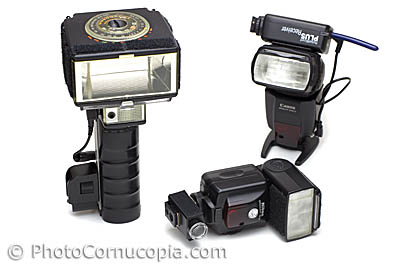 |
|
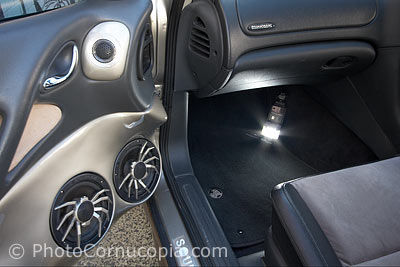 |
| You can certainly achieve
worthwhile results with simple and inexpensive strobes.
These are a good starting point for any one new to car
photography. |
|
Small flashes with
radio slaves are some times the best way to solve a lighting problem
but of course they have limited power. Radio slaves solve the
problem of synch cables getting in the shot. |
|
|
|
|
Output Power |
The flashes you choose need to
be powerful enough for the way YOU intend to work. If you
want to use soft boxes, brollies or large light modifiers
then forget about small strobes, at least for car work (but
you might have enough power for close range portraits or
detail shots, engine bays, interiors etc). Photographing
cars with small strobes tends to be quite easy as it's quite
common to use the strobes without any light modifiers so you
don't loose any of the strobes power. None the less, your
specific way of working will determine the gear you will
need. If you regularly use polarizing filters with flash
then this will effectively
reduce the flashes power by about 1.5 stops. If you tend to
shoot at F8-11 and at ISO100 (Canon), compared to ISO200
which some Nikon cameras use as a base ISO, then that's
another stop needed that the next person, a Nikon user, might not.
It's also generally better to have more power then you need,
rather than less, so err on the side of caution. |
|
Output Power Control |
The main practical requirement of any flash unit is
that it has manual output power adjustment. Flash units which only
operate at full power or on Auto settings are of very little use. The
best kinds of flashes are those that allow the output power to be
adjusted in fine increments, such as 1/3rd steps, all the way from full
power downwards. Some flashes have very course output power adjustment
such as a full stop between each setting. These can be OK but they will
always be a bit slower to get just right as they may need to be
repositioned to achieve in between power settings or possibly have
diffusing or ND (Neutral Density) gels added or removed. Flashes such as
the 580EXII and Metz 54's and 60's have 1/3 power adjustment and are quick and
easy to use. Some of the Nikon flashes, such as SB-28 (and similar
vintage) have a single step adjustment from full power to
half power and then 1/3 increments after that. This might be
because the fine adjustments, on Canon and Metz flashes
mentioned above, are rarely accurate in the full-half power
range but tend to be more accurate at lower power settings. |
|
Trigger Voltage |
The
trigger voltage is the voltage which the flash applies to the cameras
contacts, be it the 'PC contact' (usually on the front or side of the
camera body) or the 'Hot Shoe' (the flash socket on top of the camera).
The trigger voltages of flashes vary from a few volts to a few hundred
volts and are normally specified by the flash manufacturer. Your cameras
manual will specify the maximum trigger voltages your camera is designed to
handle. You can damage your camera by using a flash with a trigger
voltage higher than that which the camera is designed for. If the trigger voltage of the flash is higher than the voltage
your camera is designed for then do not connect the flash to the camera
without
an adapter designed to reduce the flashes trigger voltage to a safe
level, usually a few volts. |
|
Recycling speed |
Flashes which recycle quickly
are generally more convenient to use than flashes that take
longer to recycle. You will normally be limited by your
slowest flash as that's the flash that you will always have
to wait for. Another consideration, or at least some thing
to be aware of, is that some flashes will fire even if they
are NOT fully charged whilst other flashes will only fire
when they are at full charge. A Nikon SB-28 fires pretty
much any time the (tiny, near microscopic) test button is
pressed, regardless of the state of charge, whilst a Canon 580EXII
only fires at full charge. This can lead to inaccurate
exposures if flashes are firing at different rates of
charge. It's worth testing your flashes to at least be aware
of any possible problem. |
|
Battery |
Most flashes use AA batteries
but some older flash units can use batteries that are either
expensive, hard to get or both. The Metz 60 is an example of
the above. It uses a special version of a Sealed Lead Acid
battery which is quite expensive and needs to be replaced
every few years. |
|
Colour Temperature |
The colour of the light
emitted by a flash can change or vary for several reasons.
There are differences between brands, differences due to the
power setting used on the flash and some times differences
caused by the age or wear on the flash tube itself. The
colour temperature of most flashes will be in the same 'ball
park' and will not really matter but if you use 2 different
flashes with different colour temperatures then they may
stand out as having a different colour light if they are
used together to light adjacent parts of a car or subject.
It's a good habit to use identical brand/model of flashes
to light the side of a car if using 2 flashes. That way
the colour temp of those 2 flashes will probably be quite
close and not cause a problem. |
|
Reliability |
Buy a good flash once, not a
bunch of cheap flashes over and over again because they
break, fail, wear out etc. Nikon and Canon make very robust
flashes and their prices on the used market can be very
reasonable. |
|
Connectivity |
Not all flashes have a PC
socket built into them as standard however PC sockets are
usually required to connect the flash to a PocketWizard or
slave sync. If your flash doesn't have a PC socket then you
can normally buy an adapter which slides onto the flashes
Hot Shoe to provide either a PC cable or socket to allow
other devices to be connected to the flash. |
|
Price |
You could choose to buy 4
second hand Nikon SB-28's or 1 new Canon 580EXII for about
the same price. Their power output is virtually identical.
It really comes down to what you want and how you work. The
best option might be the most expensive one if it works best
for you. |
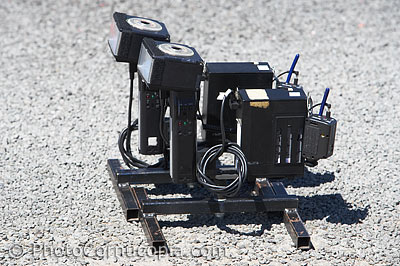 |
|
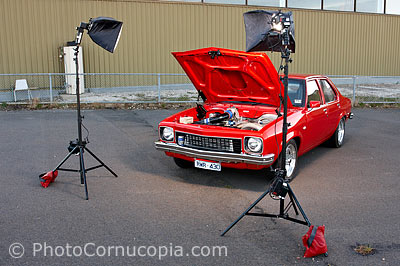 |
|
If a single strobe is not powerful enough then 2 or
more can be used to increase light output. You will
need to double the number of strobes for every extra
stop required. For example, a second strobe (2 in
total) will give you one extra stop of light. To
achieve one further stop of light you need to double
the 2 existing strobes and have 4 strobes in total.
If working at night then you can simply pop a single
strobe as many times as needed. |
|
These
softboxes are fitted to simple battery powered strobes with custom
made brackets so are compact and fast to use. Unfortunately most
small strobes loose too much power to be very useful with such light
modifiers so this is where larger and more powerful strobes have an
advantage, especially if large light modifiers are to be used. |
Triggers, radio, optical, cables, or, there's more than one way to synch
a strobe
Off camera flashes all need to fire at the same
time and the way this is done is either by connecting them to the camera
with synch cables, using light activated Slave Syncs (triggered by another
flash), using radio
transceivers such as PocketWizards or a combination of the above.
Synch cables
are a problematic because people can trip over them, they are
unreliable, they are always too short and take time to pack and unpack
properly. Keep away from them if at all possible.
Almost all studio or high end strobes have optical slaves built into
them as they are an ideal method of synching strobes in an enclosed
environment, such as a studio. Light activated slaves
can be problematic in bright sun or some times over a long distance,
even with the better quality units, but you do generally get what you
pay for so the performance of slaves can vary significantly. Although this method is the
cheapest, as all you need are cheap manual flashes and quite cheap
slaves, the disadvantage is that you will often be limited to line of
sight applications as each flashes slave must be able to see at least
one other flash so that it is activated. Optical slave syncs are very handy to have but not as a primary
method of triggering flashes other than in a closed environment such as
a studio. Optical slaves are ideal for supplementing radio triggers as
not everyone can afford to have a radio trigger for each strobe.
PocketWizards, or similar high quality radio slaves, are probably
the most important investment you can make next to the actual strobe
itself. Radio slaves have always proven to be far more reliable and quicker to
set up and use than optical slaves except possibly indoors or where the
ambient light is very low and unlikely to affect the optical slaves.
Radio slaves are not without their problems and can at times fail to
work altogether due to external or ambient radio interference beyond
your control but this is not a common problem.
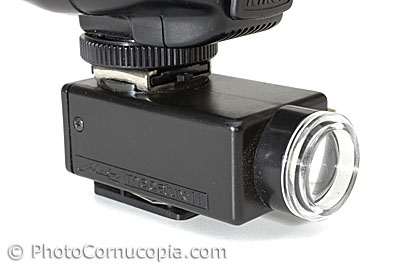 |
|
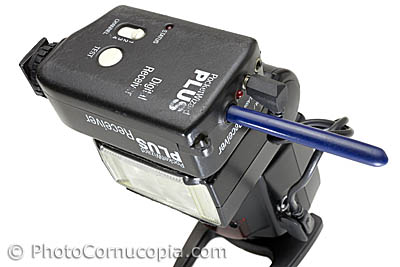 |
|
Optical slaves are very handy and cheap so
it's a good idea to have a few as spares or for any
extra flashes that only get used occasionally. Good
quality slaves can often be used in full sun if care
is given to their placement, ie preferably not
pointing directly towards the sun itself. |
|
Radio slaves are the most
practical and reliable means to synch multiple flashes. |
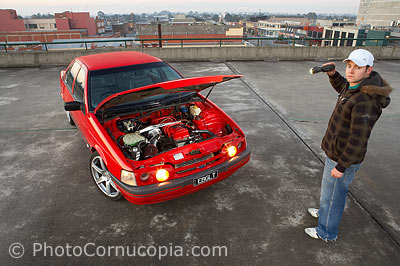 |
|
|
|
Hand held flash used to fill a dark engine bay. Note also
the sophisticated camera to flash synchronization system being being
used here. It's a proprietary system called 'Shaun'. That's right, when Shaun
hears the shutter open on the camera he presses the 'lightning bolt'
button on the flash and it makes light! It works quite well in a pinch
and when the exposures are long enough for Shaun to press the button
in time. A light stand and radio synchs would have worked just as
well but would have taken much longer to setup. Some times the
simplest method is best. |
|
|
Flash light output compared, or, how to compare apples and
oranges
A flashes power can be described in a number of ways and these
different methods can be difficult to
compare. Small flashes are often described using a Guide Number
however the methods used to determine these numbers are not
always the same so direct comparisons can not be made unless the
factors used to calculate the Guide Number is clearly defined.
The power capacity of larger strobes, such as monolights, are
usually described in Watt/Seconds (W/S) which is a description
of the electrical power storage capacity of the flash rather
than a direct measure of the light output of the unit. The two
are directly proportional, ie the higher the W/S the more
powerful the strobe and the brighter the light it creates but a
500 W/S unit from one company may or may not have the same light
output as another 500 W/S flash from another brand due to
differences in the efficiency of the electronic components and
designs.
The Guide Number of a flash is often stated by a manufacturer so
this information can be standardised to some degree for
comparison purposes and this method is used in the table below. If the
Guide Number is not know then it can be calculated from an
incident flash meter reading. It is still important to
describe the reflector or flash zoom setting used as this will
affect the intensity or concentration of the flashes light, as
can be seen in the table. As many flashes where historically
designed to have the same coverage as a 35mm lens this will be
the basis of the measurements below, and in the case of monolights, they will be tested with their standard or normal
reflector. The table below shows the test results from several
flashes as well as many flashes which have NOT been tested but
are listed simply as a guide and for comparison purposes (see
Note #3 below). Where F stops are quoted a distance of 3 metres
(3m or 10 feet) is used as the basis for all comparisons.
|
Flash |
Reflector setting
in mm and/or horizontal angle in degrees |
Manufacturers
stated Guide Number in metres
(See note #3) |
Aperture
at 3 metres or 10
feet based on manufacturers stated Guide Number
(See note #3) |
Measured/tested aperture reading
at 3 metres or 10 feet
(See note #1) |
Measured/tested
Guide Number in metres
(See note #2) |
Watts/seconds |
|
Nikon SB-28 |
35mm |
36 |
F12 |
F8.28 |
25 |
|
|
Nikon SB-28 |
85mm |
50 |
F16.6 |
F11 |
33 |
|
|
Nikon SB-900 |
35mm |
34 |
F11.3 |
|
|
|
|
Nikon SB-910 |
35mm |
34 |
F11.3 |
|
|
|
|
Canon 580EXII |
35mm |
36 |
F12 |
F7.21 |
21 |
|
|
Canon 580EXII |
105mm |
58 |
F19.3 |
F10.93
|
33 |
|
|
Canon 600EX and
600EX-RT |
35mm |
36 |
F12 |
|
|
|
|
Canon 600EX and
600EX-RT |
105mm |
58 |
F19.3 |
|
|
|
|
YONGNUO
EX600 FLASH |
105mm |
58 |
F19.3 |
|
|
|
|
YONGNUO TTL
Speedlite YN-565EX |
105mm |
58 |
F19.3 |
|
|
|
|
Sunpak Auto 511 |
35mm |
30 |
F10 |
|
|
|
|
Sunpak Auto 411 |
35mm |
30 |
F10 |
|
|
|
|
Sunpak Auto 522 |
35mm |
36 |
F12 |
|
|
|
|
Sunpak auto zoom
3600 Thyristor |
35mm |
36 |
F12 |
|
|
|
|
Sunpak Auto zoom
4000 |
75 degrees, approx
28mm |
40 |
F13.3 |
|
|
|
|
Sunpak Auto zoom
3000 |
approx 35mm |
? |
? |
F6.5 |
19 |
115 ws |
|
Sunpak Auto Pro
120J TTL |
Standard, 45
degrees |
45 |
F15 |
|
|
115 ws |
|
Sunpak Auto Pro
120J TTL |
Wide Angle, 63
degrees |
36 |
F12 |
|
|
|
|
Sunpak auto 544 |
35mm |
42 |
F14 |
|
|
|
|
Sunpak auto 555 or
G4500DX |
35mm |
45 |
F15 |
|
|
|
|
Sunpak auto 611 |
35mm |
48 |
F16 |
|
|
|
|
Sunpak 622 Super
Pro-System |
35mm |
60 |
F20 |
|
|
|
|
Sunpak auto 622
pro-system |
35mm |
50 |
F16.6 |
|
|
|
|
Metz 60 CT4 |
28mm (62 degrees) |
60 |
F20 |
F13.45 |
40 |
300 (approx) |
|
Elinchrom Ranger
Quadra AS |
RQ 13.5cm Refl.,
70 degrees, Quadra S Head |
38 |
F12.6 |
|
|
400 ws |
|
Elinchrom Ranger
Quadra AS |
RQ 18cm Refl., 55
degrees, Quadra S Head |
52 |
F17.3 |
|
|
400 ws |
|
Elinchrom Ranger
RX |
Standard, 48
degree |
128 |
F42.7 |
|
|
1100 ws |
Notes:
#1 Measured with Sekonic L-358 incident flash meter, at
ISO 100, at 1/125th
second exposure, average of at least 2 test readings
#2 Fractional aperture values used in the calculations where
sourced from How
fast is F1.2, or, fractional F-Stops compared
#3 Where ever possible, data has been sourced from
manufacturers own web sites or manuals and in some cases has
been converted or calculated to allow comparison (at ISO100
and at a distance of 3m). No
warranty is given about the accuracy of the data or
calculations. Always refer to the manufacturers web site for
accurate and up to date information about their products.
Summary
Everyone's needs and preferences will vary so choose a lighting system that
works for you. Hire equipment to try it out instead of buying and
finding it doesn't quite do what you want. The best and most expensive
gear won't necessarily be the best for you.
Definition of terms
|
Term |
Definition |
|
Flash |
The meaning of the term
'flash' has changed over time and now refers to any form
of electronic flash, regardless of the design or style
of the equipment itself. It is the most generic term
describing modern electronic flash equipment.
Historically the term referred to powder or flash bulbs
which had the exact same purpose as modern electronic
flash, ie to provide light for a photograph, albeit via
different mechanisms. |
|
Strobe |
'Strobe' is short for
'Stroboscope' which is an electronic flash designed to
pulse continuously at regular intervals, as opposed to a
typical photographic flash which only fires once each
time it is triggered. Like many words it's meaning will
depend on the context or application and if you asked an
engineer or a scientist they would probably understand a
'strobe' to be a 'stroboscope'. However in photographic
applications the term 'strobe' came into use in the
1940's and referred to any electronic flash used for
photographic purposes, ie an electronic flash. Today,
and in the context of photography, the term 'strobe' may
imply a large professional electronic flash such as
those you might find in a studio, but there is no
justification for this. 'Strobe' is simply
another name for a 'flash'. |
|
Speedlight |
The term 'speedlight'
originated in the 1940's and is a generic term referring
to any electronic flash. In common usage it still refers
to any electronic flash however its use by manufacturers
such as Nikon for small, compact hot shoe mounted
flashes has implied a meaning of small/compact hot shoe
mounted flash. Arguably the term still refers to any
electronic flash however common usage may lean towards
small/compact shoe mounted flashes. |
|
Speedlite |
The term 'speedlite' is a
trade or brand name used by various manufacturers such
as Canon and Ricoh. |
|
Monolight |
A self contained
electronic flash typically used on a light stand and in
studio environments. They are typically mains powered,
have a built in modelling light and are much more
powerful than hot shoe mounted flashes. Monolights are
distinguished from a 'power pack' based strobe which
contains the bulk of the electronics and flash controls
in the power or floor pack and with lighter/smaller and
often special purpose heads attached to the power pack
with specially designed cables. |
|
Monobloc |
Same as 'Monolight'. |
|
Strobist |
Strobist is a registered
trademark owned by David Hobby and is not a generic term
however it is frequently used online as if it where.
It's common to see the term 'strobist' used online,
usually by people new to photography, to mean 'flash
photography' itself or to refer to a type or style of
photography, ie flash photography using small strobes. |
|
Inverter |
An electronic device which
converts a low DC (direct current) voltage, eg 12/24
volts, to a higher AC (alternating current) voltage such
as 110/240v. There are many makes and models of
inverters but few are suitable for use with flash
equipment. A couple of the most commonly used inverters
are the Innovatronix Tronix Explorer range or the Paul
C. Buff Vagabond Vagabond/Mini range. |
|
Guide Number |
A Guide Number, or GN, describes
the power of a flash in a way that also allows you to
calculate the required exposure. The Guide Number is
calculated simply by multiplying the aperture and
distance. The ISO and measuring system used must also be
described, ie metric or imperial. Other factors
affecting the light output of the flash must be defined,
such as the zoom setting or reflector that was used. If
you know the Guide Number for your flash then you can
calculate the exposure by dividing the distance into the
guide number. For example a Metz 60 has a guide number
of 60 (in metres and at ISO100) so the correct exposure
for a subject 3 metres away should theoretically be
60/3=20, or F20. As can be seen in the table above the
measured exposure (averaged over 5 different Metz 60 CT4
flashes) is approx F11.5 so the measured Guide Number
based on the above tests would in be 40. In this case
the measured guide number is considerably different to
that stated by the manufacturer and it can be difficult
to know the reasons for any discrepancies but some of
the many factors could include age and condition of
equipment, the accuracy of meters used and the
environment or room where the tests are conducted etc. |
| |
|
|








